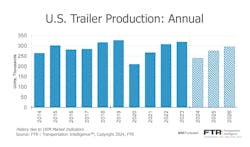The trailer industry, even during a prolonged freight recession, remains in decent shape, with 2024 production buoyed by a solid backlog of orders from the previous couple of years—or so a pair of industry analysts outlined in dueling video presentations at this year’s TTMA meeting. And, for manufacturers who became accustomed to the heady numbers during the pandemic recovery, 2025-2026 will see a return to growth, though at moderate rates.
ACT Research Vice President Steve Tam reported that GDP will continue to grow at about 2.5% in 2024—better than he’d forecast at last year’s meeting—before slowing slightly in 2025.
“This is good for our industry, of course, as economic activity drives demand for equipment—that’s the bottom line,” Tam said.
Inflation, however, has stubbornly persisted in 2024.
“If there’s one risk in our forecast from a macroeconomic perspective, I would say that that’s probably it,” Tam added. “Otherwise, the outlook is quite positive.”
Even more broadly, “geopolitical turmoil and unrest” drain global resources and add to inflationary pressures. Tam also noted the upcoming U.S. elections have little influence on the forecast, although economic activity may slow heading into the fall as business takes a more cautious approach while awaiting the outcome—and then adjusting their plans accordingly.
As to the freight outlook, trucking remains stymied by too much capacity, pressuring carrier rates and revenue.
“It’s kind of pushing the slider sideways in our industry,” Tam said. “And that’s unfortunate in this situation, but it’s the hand that we’re being dealt.”
Similarly, since carriers stuck with the historical norm of overbuying on the upswing in rates, 2024 is a year of consuming the excess while Tam anticipates 2025 “represents a return to some kind of normal activity.” Still, even as the backlog is down considerably from record levels, it’s “smack in line” with the 10-year average.
ACT Research forecasts a slowing in its freight index, though it remains slightly positive through 2024 before rebounding quickly in 2025 before leveling off.
ACT Research projects U.S. trailer production will bottom out in Q4 at 57,000 units after running at about 65,000 units per quarter for much of this year. For 2025, production will climb to about 74,000 units by the third quarter after coming in at 64,000 units in Q1.
Read more: Trailer orders tick upward, but 'pause' remains: ACT
‘Renormalization’
FTR Chairman Eric Starks, in a generally light-hearted presentation, tackled the question of the election’s impact on the economy and demonstrated that since the Clinton Administration, “they’re all the same,” with GDP growth averaging about 2.3% for the Bush, Obama, Trump, and Biden administrations.
“It does not matter who the president is to kickstart the economy,” Starks said. “It can take up to three years for underlying economic pressure to impact demand for equipment. What we do know is that the prior year has the most impact on demand for trailers, with the year before that equally weighted as the current year. So what happened last year, and the year before, has the most impact on demand and the current year. It doesn’t get any simpler than that, folks.”
As to whether 2023 and 2024 should be considered a downturn or a correction, Starks suggested these years represent “renormalization.”
“For carriers, it’s been a rate recession,” Starks continued. “But rates do not dictate demand for equipment—that comes from freight, and freight has actually been pretty flat in the last year.”
By the numbers, FTR anticipates U.S. trailer production to decline to 239,500 units in 2024. The FTR forecast has “baked in” production cuts that will “start having some teeth” in the second quarter and will continue into Q3.
Looking ahead, FTR predicts production will bounce back to 275,000 units in 2025 and 295,000 units in 2026.
The FTR model is based on “economically derived demand,” or EDD. The model goes well beyond GDP projections, as FTR forecasts freight movements down to the commodity level, segmented by mode. For highway freight, FTR even models how much freight is moving by which equipment—tractor-trailers by types, and by straight trucks. The model accounts for fleet productivity levels, load size, and lane dynamics.
FTR’s 2024 truck loadings forecast was mostly stable, with the van loadings outlook improved, according to the FTR April analysis. The growth forecasts for flatbed and tank were slightly weaker than in the prior forecast, mostly offsetting slightly stronger forecasts for dry van and refrigerated.
Segment outlook
By segment, FTR forecasts for U.S. trailer production are:
Dry Van: Outlook calls for 2024 production to finish at 144,500 (down 24.5%) and come in at 166,573 in 2025 and 178,780 in 2026.
Refrigerated Van: Outlook calls for 2024 to finish at 37,400 (down 19.2%) and come in at 42,737 in 2025 and 45,814 in 2026.
Flatbed: Outlook calls for 2024 to finish at 18,500 (down 39.9%) and come in at 21,494 in 2025 and 23,124 in 2026.
About the Author
Kevin Jones
Editor
Kevin has served as editor-in-chief of Trailer/Body Builders magazine since 2017—just the third editor in the magazine’s 60 years. He is also editorial director for Endeavor Business Media’s Commercial Vehicle group, which includes FleetOwner, Bulk Transporter, Refrigerated Transporter, American Trucker, and Fleet Maintenance magazines and websites.
Working from Beaufort, S.C., Kevin has covered trucking and manufacturing for nearly 20 years. His writing and commentary about the trucking industry and, previously, business and government, has been recognized with numerous state, regional, and national journalism awards.



